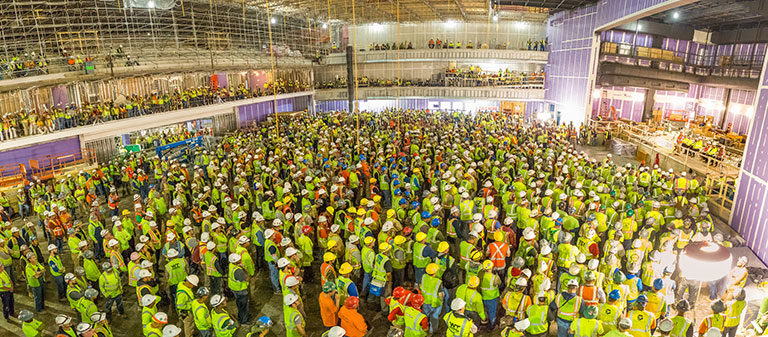Safety groups: ‘Stand down’ to help protect construction workers

Speakers address the crowd during the third annual National Safety Stand-Down at MGM National Harbor in Oxon Hill, MD.
Photo: Shawn T. Moore/Department of Labor
Washington – Construction employers are being encouraged to stop work and talk with employees about fall hazards and prevention as part of the fourth annual National Safety Stand-Down to Prevent Falls in Construction, set to take place May 8-12.
Falls are the No. 1 cause of death among construction workers, accounting for 37 percent of deaths in the industry, according to NIOSH. In an effort to save lives and prevent injuries, OSHA, NIOSH, the Center for Construction Research and Training (also known as CPWR) and many others have teamed up to organize a national safety stand-down.
More than 10,000 organizations with more than 2 million workers have participated in past events, according to OSHA. New participants this year will receive a certificate of completion from OSHA, and returning participants will receive the next level of certification.
“It is through this combined effort and commitment among many partners, employers and workers that the National Safety Stand-Down has been successful in its reach, and we look forward to the continued investment demonstrated in support of fall prevention,” NIOSH Director John Howard said in a press release. “Having a vested interest in standing down operations and taking a moment to emphasize worker safety combats a preventable public health problem and promotes a positive work culture.”
Suggestions from OSHA regarding what to do during the stand-down include picking a topic and having a toolbox talk on it, inspecting safety equipment, creating a rescue plan and discussing job-specific hazards.
“In an industry like construction, where workers change companies and jobsites regularly, it is important to reinforce lessons in fall prevention year after year,” CPWR Executive Director Chris Trahan Cain said in the release. “With that in mind, we would encourage companies who have participated in past stand-downs to join us once again, and companies who are new to the event to make this year the first of many.”
Post a comment to this article
Safety+Health welcomes comments that promote respectful dialogue. Please stay on topic. Comments that contain personal attacks, profanity or abusive language – or those aggressively promoting products or services – will be removed. We reserve the right to determine which comments violate our comment policy. (Anonymous comments are welcome; merely skip the “name” field in the comment box. An email address is required but will not be included with your comment.)

